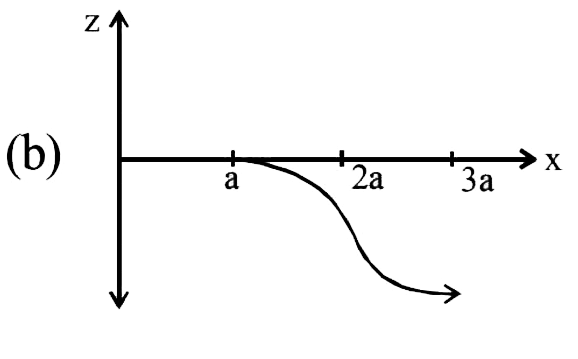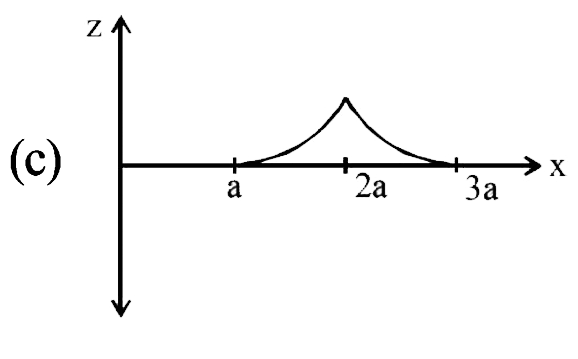In a region of space , suppose there exists a uniform electric field →E=10ˆi(Vm) . If a positive charge moves with a velocity →v=−2ˆj, its potential energy
Increases
Decreases
Does not change
Initial increases then decreases
The correct Answer is:3
Step by step video, text & image solution for In a region of space , suppose there exists a uniform electric field vec(E ) = 10 hat(i) ( V /m) . If a positive charge moves with a velocity vec(v ) = -2 hat(j), its potential energy by Physics experts to help you in doubts & scoring excellent marks in Class 12 exams.
Updated on:21/07/2023Topper's Solved these Questions
- ELECTROSTATIC POTENTIAL AND CAPACITANCE BOOK - AAKASH INSTITUTECHAPTER - ELECTROSTATIC POTENTIAL AND CAPACITANCE EXERCISE - SECTION-B (OBJECTIVE TYPE QUESTIONS (ONLY ONE ANSWER) )
1 Videos
- ELECTROSTATIC POTENTIAL AND CAPACITANCE BOOK - AAKASH INSTITUTECHAPTER - ELECTROSTATIC POTENTIAL AND CAPACITANCE EXERCISE - SECTION-B(OBJECTIVE TYPE QUESTIONS(ONLY ONE ANSWER) )
23 Videos
- ELECTROSTATIC POTENTIAL AND CAPACITANCE BOOK - AAKASH INSTITUTECHAPTER - ELECTROSTATIC POTENTIAL AND CAPACITANCE EXERCISE - TRY YOURSELF
110 Videos
- ELECTROMAGNETIC WAVESBOOK - AAKASH INSTITUTECHAPTER - ELECTROMAGNETIC WAVESEXERCISE - ASSIGNMENT SECTION - D Assertion-Reason Type Questions
25 Videos
- GRAVITATION BOOK - AAKASH INSTITUTECHAPTER - GRAVITATION EXERCISE - ASSIGNMENT SECTION - D (ASSERTION-REASON TYPE QUESTIONS)
16 Videos
Similar Questions
There exist uniform magnetic field →B=5T(−ˆj) from x=0 to x=2m. From x=2m to x=4m a uniform electric field →E=50N/C(−ˆk). A point chage (q=2C,m=1kg) is projected from origin with velocity →V=20m/s(ˆk). Speed with which the charge particle will leave the electric fields is 10√nm/s. Find the value of n

View SolutionIn a certain region static electric and magentic fields exist. The magnetic field is given by →B=B0(ˆi+2ˆj−4ˆk). If a test charge moving with a velocity, →υ=υ0(3ˆi−ˆj+2ˆk) experience no force in that region, then the electric field in the region, in SI units, is-
View Solution
Knowledge Check
The potential field of an electric field →E=(yˆi+xˆj) is
AV=−xy+constantBV=−(x+y)+ constantCV=−(x2+y2)+ constantDV = constantConsider the motion of a positive point charge in a region where area simultaneous uniform electric and magnetic fields →E=E0ˆj and →B=B0ˆj. At time t=0 , this charge has velocity →v in the x−yplane , making an angle θ with the x−aξs. Which of the following option(s) is (are) correct for time t>0?
AIf θ=0∘ , the charge moves in a circular path in the x−z plane.BIf θ=0∘, the charge undergoes helical path motion with constant pitch along the y−aξs.CIf θ=10∘,thechar≥undergoeshelicalmotionwithitsπtch∈creasingwithtime,alongthe y - axis.DIf θ=90∘ the charge undergoes linear but accelerated motion along the y−aξs.A magnetic field →B=B0ˆj , exists in the region a<x<2a , and vec(B) = -B_(0) hat(j),∈theregion2a lt xlt 3a,whereB_(0)isapositiveconstant.Apositivep∮char≥mov∈gwithavelocityvec(v) = v_(0) hat (i),wherev_(0) is a positive constant , enters the magnetic field at x=a . The trajectory of the charge in this region can be like
 A
A B
B C
C D
D
An electron of charge −e, mass m, enters a uniform magnetic field →B=Bˆi with an initial velocity →v=vxˆi+vyˆj. What is the velocity of the electron after a time interval of t seconds?
View SolutionA particle ( mass = m and charge = q ) is moving in a region in which there exists a uniform electric field E→i and a uniform magnetic field Bˆk. At t = 0 , the particle is at ( 0,a ) and is moving with vˆi. After some time, the particle is located at ( 2a, 0 ) and has a velocity −2vˆj , then which of the following is true ?
View SolutionA particle of charge q and mass m starts moving from the origin under the action of an electric field →E=E0ˆiand→B=B0ˆi with a velocity →v=v0ˆj. The speed of the particle will become 2v0 after a time.
View SolutionA charged particle with charge to mass ratio (qm)=(10)319Ckg−1 enters a uniform magnetic field →B=20ˆi+30ˆj+50ˆkT at time t = 0 with velocity →V=(20ˆi+50ˆj+30ˆk)m/s. Assume that magnetic field exists in large space.
During the further motion of the particle in the magnetic field, the angle between the magnetic field and velocity of the particle
View SolutionAn alpha particle moving with a velocity →v1=2ˆim/s is a uniform magnetic field experiences a force →F1=−4e(ˆj−ˆk)N. When the particle moves with a velocity →v2=ˆjm/s, then the force experienced by it is →F2=2e(ˆi−ˆk)N. The magnetic induction →B at that point is :
View Solution
